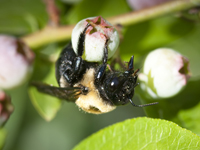|
Bumbles
and Blueberries
by Sujaya Rao and W. P. Stephen, Crop and Soil Science Department,
Oregon State University
Pollination is critical for production of large, good quality and
earlier ripening blueberries. Native bees, especially bumble bees,
are considered to be excellent pollinators of blueberries as, unlike
honey bees, they forage in the cool temperatures that prevail during
blueberry bloom in the Willamette Valley and they remove blueberry
pollen efficiently through buzz pollination.
 Research
at Oregon State University (OSU) has documented that an abundance
of bumble bees belonging to seven species forage on blueberry flowers
and likely contribute to the high yields obtained in the Willamette
Valley. However, climatic conditions, which vary from year to year,
affect bumble bee colony development and foraging behavior, both
of which could in turn affect blueberry pollination and berry yield.
In addition, due to their long life cycle, bumble bees are dependent
on crops besides blueberries for colony development. Bumble bee
queens emerge from hibernation in spring and forage on blueberries
and other spring blooming crops prior to initiating nests. Subsequently,
workers forage in late spring and summer and colonies increase in
size prior to the production of males and new queens that mate before
the mated queens go into hibernation. Research
at Oregon State University (OSU) has documented that an abundance
of bumble bees belonging to seven species forage on blueberry flowers
and likely contribute to the high yields obtained in the Willamette
Valley. However, climatic conditions, which vary from year to year,
affect bumble bee colony development and foraging behavior, both
of which could in turn affect blueberry pollination and berry yield.
In addition, due to their long life cycle, bumble bees are dependent
on crops besides blueberries for colony development. Bumble bee
queens emerge from hibernation in spring and forage on blueberries
and other spring blooming crops prior to initiating nests. Subsequently,
workers forage in late spring and summer and colonies increase in
size prior to the production of males and new queens that mate before
the mated queens go into hibernation.
Thus, for availability of bumble bees for pollination the following
year, blueberry crops must provide sufficient foraging resources
early in the season to ensure that queens have adequate resources
to initiate nests while alternative resources are required in the
landscape for sustenance of colonies through the rest of the year.
In other regions in the U.S. blueberry growers can purchase commercial
bumble bees to augment native populations for blueberry pollination
but this is not permitted in Oregon as commercial bumble bees are
not native. OSU researchers are working with beekeepers for production
of West Coast bumble bee species that will be available for blueberry
pollination. Meanwhile, blueberry growers can facilitate bumble
bee conservation by planting bee-pollinated flowering plants that
bloom either before or after blueberry bloom in their orchards.
|
Articles:
Message from the Chairman
Spotted
Wing Drosophila Update
Market
Outlook:
A Look Back …
and Ahead
Bumbles
and Blueberries
Organic
Blueberry Production Research Project
Critical
Program Needs Industry Support
Small
Growers to Receive GAP Certification Aid
Oregon
Fresh Season Promotion On a Roll for 2011
Bee
Fees Jump a Bit
Smooth
Move Increases Insulin Sensitivity
New
Trap Hits
the Spots
(Spotted Wing Drosophila)
OSU
Researcher Driving Blueberries up a Tree
USHBC
Unveils New “Little Blue Dynamos” Positioning and Campaign
for Highbush Blueberries
Watching
World Acreage and
Production Grow
Specialty
Crop Grant Supports Oregon Berry Festival;
Free Berry Vendor Space Available
|

 Research
at Oregon State University (OSU) has documented that an abundance
of bumble bees belonging to seven species forage on blueberry flowers
and likely contribute to the high yields obtained in the Willamette
Valley. However, climatic conditions, which vary from year to year,
affect bumble bee colony development and foraging behavior, both
of which could in turn affect blueberry pollination and berry yield.
In addition, due to their long life cycle, bumble bees are dependent
on crops besides blueberries for colony development. Bumble bee
queens emerge from hibernation in spring and forage on blueberries
and other spring blooming crops prior to initiating nests. Subsequently,
workers forage in late spring and summer and colonies increase in
size prior to the production of males and new queens that mate before
the mated queens go into hibernation.
Research
at Oregon State University (OSU) has documented that an abundance
of bumble bees belonging to seven species forage on blueberry flowers
and likely contribute to the high yields obtained in the Willamette
Valley. However, climatic conditions, which vary from year to year,
affect bumble bee colony development and foraging behavior, both
of which could in turn affect blueberry pollination and berry yield.
In addition, due to their long life cycle, bumble bees are dependent
on crops besides blueberries for colony development. Bumble bee
queens emerge from hibernation in spring and forage on blueberries
and other spring blooming crops prior to initiating nests. Subsequently,
workers forage in late spring and summer and colonies increase in
size prior to the production of males and new queens that mate before
the mated queens go into hibernation.